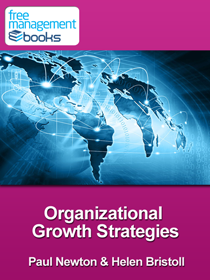Organizational Growth Strategies - Free eBook in PDF Format
 |
 |
|
Book Description - ISBN 978-1-54345-824-9 (40 Pages)
This free eBook describes five models of organizational growth. The most successful organizations are continually reviewing their operational processes and strategies to ensure future growth and you can use these models to help you to see the growth opportunities for your organization.
Chapter 1 - The McKinsey 7-S Framework
Organizations must ensure that all its actions are designed to help it move closer and closer to its stated goals. To be successful all business units within the organization must work cohesively as a unit checking off goals one at a time. The McKinsey 7-S Framework uses seven components - Strategy, Structure, Systems, Shared Values, Skills, Style and Staff - to develop your organizational strategy and attain its ultimate goal.
Chapter 2 - Miles & Snow’s Organizational Strategies
Miles and Snow’s Organizational Strategies tool enables you to match up organizational goals with its ongoing strategies. The four unique strategies - Prospector, Defender, Analyzer and Reactor - presented in this tool offer considerable guidance to management ensuring that all actions taken are working toward the same desired result.
Chapter 3 - Mintzberg’s Organizational Configurations
Mintzberg’s Organization Configurations can help business owners and managers to understand how to set up their operation based on what they are trying to accomplish. The model has five ‘organization’ structures – Entrepreneurial, Machine, Professional, Divisional and Innovative - to help management determine, which is the most effective for them based on their specific goals and market.
Chapter 4 - McKinsey’s Seven Degrees of Freedom for Growth
The Seven Degrees of Freedom for Growth tool from McKinsey helps organizations and management to think creatively about how they can expand. It outlines seven unique ways an organization can achieve growth. The final option adopted by management will depend on several things, for example, the market sector, the ‘health’ of the organization etc.
Chapter 5 - Mullins’ Seven Domains Model
Mullins’ Seven Domains model has been specifically designed to help those thinking about starting up a new venture so that the organization is structured in the most efficient way for long-term success. It divides the domains into macro and micro aspects, with the latter relating directly to you and your team.
| You will learn about: |
|
![]()
![]()
What is the McKinsey 7-S Framework?
- The McKinsey 7-S Framework is a tool designed to help business owners and managers understand how aligned their organization is, and where it can be approved.
- The framework is most often used as an organizational analysis tool to assess and monitor changes in the internal situation of an organization.
- It is based on the theory that, for an organization to perform well, seven elements need to be aligned and mutually reinforcing. They are:
- Strategy – Purpose of the business and the way the organization seeks to enhance its competitive advantage.
- Structure – Division of activities; integration and coordination mechanisms.
- Systems – Formal procedures for measurement, reward and resource allocation.
- Shared Values – The overall culture of the company, and the purpose behind everything that is done.
- Skills – The organization’s core competencies and distinctive capabilities.
- Staff – Organization’s human resources, demographic, educational and attitudinal characteristics.
- Style – Typical behaviour patterns of key groups, such as managers, and other professionals.
- The framework can be used to help identify what needs to be realigned to improve performance, or to maintain performance during other types of change.
What are Miles & Snow’s Organizational Strategies?
- Miles and Snow suggest that business level strategies generally fall into one of four categories: prospector, defender, analyzer, and reactor.
- A Prospector is innovative and growth oriented, searches for new markets and new growth opportunities, and encourages risk taking.
- A Defender protects their current markets, maintains stable growth, and serves current customers.
- An Analyzer maintains current markets and current customer satisfaction with moderate emphasis on innovation.
- A Reactor has no clear strategy but reacts to changes in the environment and drifts with events.
- The ideas presented in this tool can be greatly helpful when trying to ensure that all actions taken within an organization are working toward the same desired result.
What are Mintzberg’s Organizational Configurations?
- Mintzberg’s Organizational Configurations can help business owners and managers to understand exactly how they should be setting up their operation based on what they are trying to accomplish.
- The model uses five idealized organisational configurations that managers a framework to understand and design organisational structures.
- An entrepreneurial organization is one that has a very simple decision making process in which the business owners make all of the decisions.
- A machine organization has a list of well-defined procedures that negate the need for decision making which is done ‘by the book’.
- A professional organization is one in which individual professionals are able to operate with a certain level of autonomy. Accountancy and law both fall into this category.
- A divisional organization relies on the standardisation of outputs where line managers run independent divisions.
- An innovative organization does not try to develop any kind of structure or hierarchy for decision making, but instead adapts from day to day based on need.
- This model is not designed to provide guidance for setting up an organisation’s decision making structure but it can help you to understand how organisations change over time and how their decision making structures evolve.
What are McKinsey’s Seven Degrees of Freedom for Growth?
- You can use the Seven Degrees of Freedom for Growth tool from McKinsey to help you think creatively about how to grow your existing business.
- Selling Existing Products to Existing Customers: This is perhaps the most obvious, but also the most limited, of the options on the list.
- Acquiring New Customers in Existing Markets: Taking your marketing in a new direction might be the best option for engaging a new segment of the market as a whole.
- Creating New Products and Services: Selling into a related market means that you can continue to build brand loyalty and recognition while having an easier time getting the new products off the ground.
- Developing New Value-Delivery Approaches: Common ways to add value include streamlining production in order to lower prices, or improving the overall quality of the product while keeping the price constant.
- Moving Into New Geographies: This allows you to continue to grow after you have already drawn everything you can out of your current markets.
- Creating a New Industry Structure: Can you find any companies that would make for a natural fit with your own to form a partnership of some kind?
- Opening Up New Competitive Arenas: By moving your company into new arenas where you can compete for new customers is one way to open yourself up to the potential for rapid growth.
- This model can help you to see growth opportunities that are not immediately obvious.
What is Mullins’ Seven Domains Model?
- Mullins’ Seven Domains Model is designed to help those thinking about starting up a new venture.
- Four of the domains fall into the category of ‘macro’ aspects, while three are considered ‘micro’ points that relate specifically to you and your team.
- Market Attractiveness: How attractive is the market in terms of size and maturity?
- Sector Market Benefits and Attractiveness: How attractive is the sector in terms of size and maturity?
- Industry Attractiveness: Can you compete in this industry? What is the level of competition?
- Sustainable Advantage: If you develop a unique selling proposition, can you maintain that advantage in the future?
- Mission, Aspirations, Propensity for Risk: Are you truly passionate about the business idea itself and are you happy with the level of risk it involves?
- Ability to Execute on Critical Success Factors: Is the team you have in place going to be able to hit on all of the critical success factors well enough to ensure your success?
- Up, Down, Across Value Chain: Do you have or can you develop the connections you need to succeed?
- Each of the seven domains listed above is incredibly important to the success of your potential business venture.


